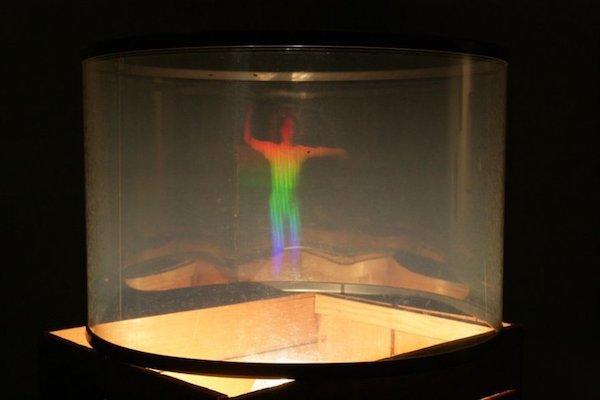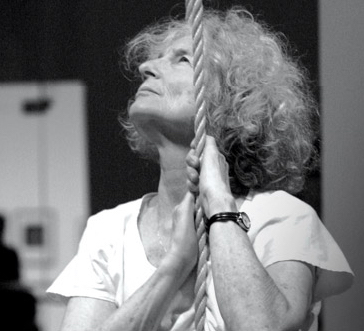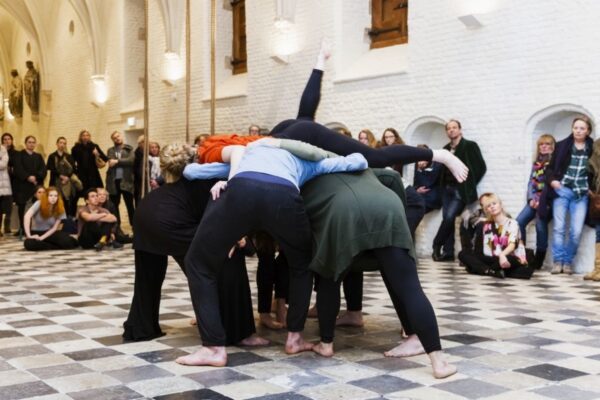This month, the Venice Biennale announced Simone Forti will receive a lifetime achievement award. Her first major West Coast museum exhibition has opened and includes live performances of her now legendary Dance Constructions. If there was any doubt, these are clear signs that Forti is having her moment. It’s equally clear she took the scenic route to arrive.
Long an influential presence in SoCal dance, Forti’s story starts in Italy where she was born in 1935, and where the prestigious Venice Biennale recently bestowed on her the 2023 Golden Lion Award for Lifetime Achievement in dance. Leaving Italy in 1939, her family settling in L.A. until Forti went to San Francisco to dance “in the woods” as she describes it, then she headed to New York and made her name as part of the post-modern Judson Church Collective in the late 1950s and 1960s. Still restless, she left New York, eventually returning to LA where, with other Judson Church alums like Rudy Perez, Forti contributed post world war II artistic sensibilities to California dance. Throughout her career, Forti forged creative partnerships in dance and the visual arts, filled notebooks with sketches for her dances, and explored early holograms that have been described as “capturing dance movement for eternity.” She turns 88 on March 25, and Forti can celebrate at LA’s MOCA on Grand Avenue at the first major West Coast museum exhibition focused on both her art and her choreography.

While her reputation as a choreographer and the chance to see Forti’s seminal work performed live is a draw for the dance community, the MOCA exhibition co-curators Rebecca Lowry and Alex Sloane think it is important also to view Forti as an artist who has investigated movement through drawings, videos, sculptures, poetry, and holograms. Evidenced by more than 80 works displayed in the exhibition, her work as a visual artist is substantial. In 2019, the Getty Research Institute acquired much of Forti’s archive including journals, notebooks, family documents, sketches, photographs, correspondence, posters and audio-visual material which GRI staff have been cataloguing and digitizing. MOCA curators coordinated with the GRI which provided some of the material being included in this exhibition along with loans from New York’s Museum of Modern Art, the Art Institute of Chicago, the LA County Museum of Art, and Fortis’ long-time gallery The Box.
Over her decades in Los Angeles, Forti, a riveting performer, explored improvisation and collaborative efforts, notably with Sarah Swenson and Carmela Hermann Dietrich, both of whom are involved with the live performances of Dance Constructions. Forti also developed a deep ongoing relationship with The Box as a gallery and performance space, and Jason Underhill is credited as a guest curator for the exhibition. While health issues have curtailed Forti’s activities, Swenson and Hermann Dietrich have overseen the re-creation of Dance Constructions with two different casts trading off performing duties.

First presented in 1960 in New York with additional “constructions” added the next spring, the nine Dance Constructions are still considered Forti’s seminal post modern work exploring the artistic potential in pedestrian movement and referencing the minimalism influences of post World War II art and writing. Today, “pedestrian” movement is an accepted part of contemporary dance, but 60 years ago was considered radical and disruptive of the then prevailing view of modern dance. As Forti expressed in a 2019 interview,
“When I was in my 20s, we were asking some basic questions, not just dancers, but visual artists and writers too. What are we doing? Why do we do it? What forms can it take? In dance, we found we were not looking at our ancestors and our work had to be more conceptional because there wasn’t a format that we could fill. We had to invent what the format would be whether that be for painting or language or movement.”

The three sections of her Dance Constructions being performed live each week during the exhibition reflect Forti’s answers to those questions 60 years ago.
In Hangers (1961), rope comes into play as a performer on the ground moves among others perched above in loops of rope. Rope makes another appearance in Slant Board (1961), as performers employ ropes to move in various directions and among one another on the large, tilted plywood ramp in the title. In the third work, Huddle (1961), a cluster of performers initially appear like a sculpture, completely still, until one by one they begin moving out from the group and climbing over the others.

The two rotating casts include Loay Al Derazi, Rodrigo Arruda, Alan Duff Berman, Miles Brenninkmeijer, John Brutle, Kyla Carter, Milka Djordjevich, Alexsa Durrans, Gabriela Enciso, Jennifer Galipo, Abriel Gardner, Chelsea Gaspard, Peter Kalisch, Zoe Rappaport, Kim Schnaubert, Michelle Sui, devika wickremesinghe, and Melina Wilcox.
Unlike the writings, drawings, and sculpture, since their creation in 1961 Dance Constructions have had a life of their own. In a recent interview in the New York Times, Forti talked about how Huddle has evolved over the decades. She described the original as rougher and more compact, but over time has come to evoke a sense of community and care which she attributed to the embrace of body work, craniosacral therapy, and meditation. Huddle is frequently performed including a performance in Florence, Italy piazza in front of a copy of Michelangelo’s David, which may have contributed to Forti’s stature in Italy and the recent lifetime achievement award.

Dance Constructions at MOCA Grand Avenue (Museum of Contemporary Art), 250 S. Grand Ave., downtown; Exhibit runs to Sun., April 2. Performances of Dance Constructions performed Thurs., 3:30, 4:45, 6:00, & 7:15 pm, Sat. & Sun., 12:30, 1:45, 3:00, & 4:15 pm, throughout the exhibit run, free with timed museum admission. MOCA.
